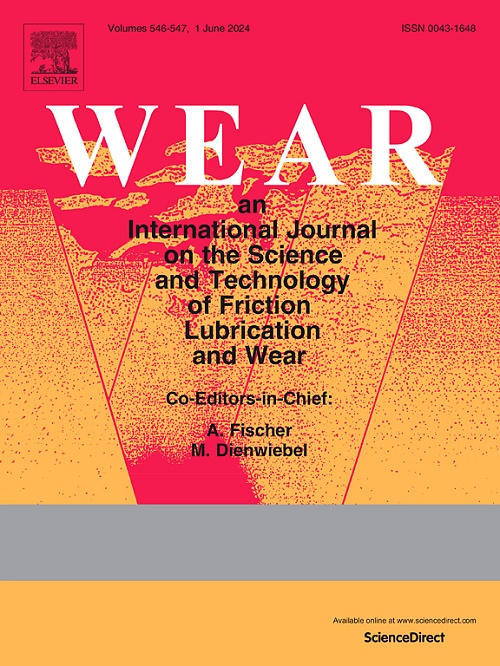Formation of a wear-protective glaze layer on GCr15 bearing steel under dry sliding at room temperature
IF 5.3
1区 工程技术
Q1 ENGINEERING, MECHANICAL
引用次数: 0
Abstract
The formation of a protective glaze layer during sliding in high-temperature environments usually enhances the wear resistance of metallic materials. However, GCr15 bearing steels typically operate at temperatures below 160 °C, making it difficult to form a glaze layer within this temperature range. In this work, surface mechanical rolling treatment (SMRT) is used to produce a ∼750 μm-thick gradient nanostructured (GNS) surface layer on GCr15 bearing steel. The friction and wear properties of the SMRT samples were investigated to explore if a wear-protective glaze layer can be formed during dry sliding at room temperature. Analyses on the surface morphologies and compositions revealed that the glaze layers were successfully generated on the worn surface for the SMRT samples, mostly related to abundant oxides generated on the worn surface as a result of fast grain boundary diffusivities and high nucleation rates in the nano-grained surface layer. The formation of a protective glaze layer consists of Fe2O3 and SiC results in the significant decreases in the coefficients of friction and wear volumes by inhibiting the occurrence of severe adhesion. After sliding for 9000 cycles, the wear volume of the SMRT samples was reduced by ∼53.2 % relative to that of as-received (AR) samples at a load of 110 N. In comparison, adhesion induced Si-rich amorphous phases on the worn surface might hinder the diffusion of oxygen and suppress the formation of glaze layer on the AR samples under dry sliding.
GCr15轴承钢在室温干滑动条件下形成耐磨釉层
在高温环境下,金属材料在滑动过程中形成的保护釉层通常会增强其耐磨性。然而,GCr15轴承钢通常在低于160°C的温度下工作,这使得在该温度范围内难以形成釉层。在这项工作中,使用表面机械轧制处理(SMRT)在GCr15轴承钢上产生了~ 750 μm厚的梯度纳米结构(GNS)表面层。研究了SMRT试样的摩擦磨损性能,探讨了在室温干滑动过程中是否能形成保护磨损的釉层。表面形貌和成分分析表明,SMRT样品在磨损表面成功生成釉层,这主要与磨损表面纳米晶层晶界扩散快、晶核率高而产生丰富的氧化物有关。由Fe2O3和SiC组成的保护釉层的形成抑制了严重粘附的发生,从而显著降低了摩擦系数和磨损体积。经过9000次循环的滑动后,SMRT样品的磨损体积相对于接收(AR)样品在110 n载荷下减少了~ 53.2%。相比之下,在干滑动条件下,磨损表面粘附诱导的富si非晶态相可能会阻碍氧的扩散,抑制AR样品上釉层的形成。
本文章由计算机程序翻译,如有差异,请以英文原文为准。
求助全文
约1分钟内获得全文
求助全文
来源期刊

Wear
工程技术-材料科学:综合
CiteScore
8.80
自引率
8.00%
发文量
280
审稿时长
47 days
期刊介绍:
Wear journal is dedicated to the advancement of basic and applied knowledge concerning the nature of wear of materials. Broadly, topics of interest range from development of fundamental understanding of the mechanisms of wear to innovative solutions to practical engineering problems. Authors of experimental studies are expected to comment on the repeatability of the data, and whenever possible, conduct multiple measurements under similar testing conditions. Further, Wear embraces the highest standards of professional ethics, and the detection of matching content, either in written or graphical form, from other publications by the current authors or by others, may result in rejection.
 求助内容:
求助内容: 应助结果提醒方式:
应助结果提醒方式:


